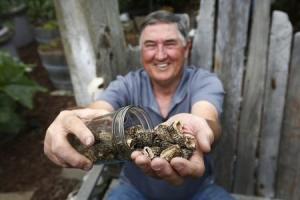
San Francisco Mycological Society President Curt Haney displays some dried morel mushrooms at his home …
by Mary Papenfuss
Smugglers in northern California’s fire-ravaged
Stanislaus National Forest are sneaking out pricey contraband - not
marijuana this time, but a favorite delicacy of foodies: the luscious
morel mushroom.
Despite a record “flush,” or bloom, of the
tasty, wild fungi, mushroom hunters are banned from the forest because
officials believe that scorched, unstable tree trunks, eroded soil and
logging operations after last August’s massive Rim Fire have made the
area too dangerous.
That
means as much as $40 million in a bumper crop of morels — ironically
sparked by the same fire that is blocking hunters — is rotting in the
woods west of Yosemite Park.
“It’s a shame to let those morels
go to waste,” said Curt Haney, president of the San Francisco
Mycological Association, who doesn’t believe conditions are any more
dangerous than in other, less productive, burn areas where gatherers
have access.
As firefighters
in Stanislaus battled last summer's 400-square-mile Rim Fire, the third
largest in California history, mushroom hunters were “salivating” in
anticipation of the morels in the fire’s wake, said Haney.
Soil nutrients from burned and rotting trees are a perfect medium for morels, says U.S. forester Marty Gmelin.
Attempts to cultivate morels are rarely successful, making them a
world-class delicacy. The season in northern California is expected to
finish around the end of June.
While mushroom hunters may be willing to sign safety waivers for
access, the Stanislaus National Forest spokeswoman Rebecca Garcia says
it “doesn’t absolve the U.S. Forest Service of liability. We can’t allow
the public in risky areas.”
Todd Spanier, founder of King of Mushrooms, the largest commercial
distributor of wild mushrooms in the San Francisco Bay Area, believes
banning the hunt may have cost the local economy as much as $160 million
in lost revenue from gatherers traveling from other states and
countries, and in morel sales at food stores and restaurants.
Retail prices for fresh morels range from $25 to $40 per pound, Spanier said.
“It’s a tremendous lost opportunity,” he explained. “We might not see this in the Sierras for another 10 years.”
Visitors can drive in the forest for hours without escaping the ravages
of the fire - stands of stripped, blackened trunks rising from barren
moonscapes of scorched earth. Other trees are half green, half withered
brown.
The Forest Service is
currently clearing trees around roads and popular areas. Highway 120
through Stanislaus is open, but the public has access only to specific
campgrounds, picnic areas and kayak launch spots.
“They have to stay there; they can’t take a hike; it’s too dangerous,” said Gmelin. Mushroom hunting is not allowed.
Yet, despite the ban, and threat of a $5,000 fine and six months in
jail, smugglers are hauling out hundreds of pounds of morels, and
enforcement personnel are confiscating contraband daily, said Garcia.
Groveland mushroom hunter
Ryan Evans said he knows gatherers who have “pulled out so many morels
that they’re sick of picking them, and everyone is serving morels at
home. I’ve never seen anything like this.”
To avoid suspicion, Evans said the trick is to hike, not drive, to mushroom areas.
Mushroom hunters are easily spotted in local bars, he noted, because they are dressed head-to-toe in camouflage.
Spanier is currently buying up to a half ton of morels each week, and
he suspects half of that is being illegally picked in Stanislaus. Still,
he adds, “it’s a drop in the bucket compared to what’s available” in
the forest.

No comments:
Post a Comment